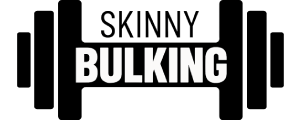Being skinny can often make it difficult to feel comfortable in your own skin, and can leave some people feeling self-conscious in social situations. However, incorporating a consistent fitness plan is a great way to help skinny guys build muscle and feel more confident in their bodies. In this post, we will share a 12-week fitness plan that has been specially designed for skinny guys to help you build strength and endurance while also packing on some lean muscle. From setting realistic goals to customizing your workout routine to suit your fitness level, we will cover everything you need to know to achieve your fitness goals and transform your body. So get ready to build some muscle, gain confidence, and improve your overall health and fitness with this ultimate 12-week fitness plan for skinny guys.
1. Introduction to the struggles of skinny guys in the gym

Image: pexels
If you are a skinny guy who is looking to build muscle, then you already know how challenging it can be to gain weight and see progress in the gym. You may feel like you are constantly eating, lifting heavy weights, and pushing yourself to the limit, yet you still don’t see the results you want.
One of the biggest struggles skinny guys face in the gym is not seeing the progress they want quickly enough. It can be discouraging to see others around you who seem to be making gains much faster than you are. However, it’s important to remember that everyone’s body is different and gains take time.
Another challenge for skinny guys is figuring out the right workout routine and diet plan. With so much conflicting information out there, it can be overwhelming to know where to start. You may also struggle with knowing how much to eat and what types of food to eat to support your muscle-building goals.
Despite these challenges, it’s important to stay focused and committed to your fitness journey. With the right plan in place, consistent effort, and patience, you can achieve the gains you want and build the muscular, toned physique you desire. So, let’s dive into the ultimate 12-week fitness plan for skinny guys that will help you reach your goals.
2. The importance of nutrition for building muscle
When it comes to building muscle, nutrition is just as important as exercise. After all, your muscles need fuel to grow and recover.
If you’re a skinny guy looking to bulk up, you’ll need to eat more calories than you burn. This is known as a caloric surplus. Eating a balanced diet that includes plenty of protein, complex carbohydrates, and healthy fats is essential for muscle growth.
Protein is particularly important as it provides the building blocks necessary for muscle growth. Aim to consume around 1 gram of protein per pound of body weight each day. Good sources of protein include lean meats, fish, eggs, dairy, and plant-based sources such as beans, lentils, and tofu.
In addition to protein, carbohydrates provide energy to fuel your workouts and aid in recovery. Opt for complex carbohydrates such as whole grains, fruits, and vegetables, which provide sustained energy and are rich in vitamins and minerals.
Healthy fats also play a role in muscle growth and overall health. Include sources such as nuts, seeds, avocados, and olive oil in your diet.
Finally, staying hydrated is crucial for optimal muscle function and recovery. Aim to drink at least 8-10 glasses of water per day, and more if you’re sweating heavily during exercise.
By fueling your body with the right nutrients, you’ll be giving yourself the best chance at building muscle and achieving your fitness goals.
3. How to determine your caloric needs for muscle gain
Determining your caloric needs is crucial when it comes to gaining muscle. If you’re a skinny guy looking to bulk up, you’ll need to consume more calories than you burn in a day. This is known as a caloric surplus. However, you can’t just eat anything and everything. You need to be consuming the right types of calories.
To determine your caloric needs, you need to calculate your basal metabolic rate (BMR). This is the number of calories your body needs to function at rest. There are a number of online calculators that can help you determine your BMR based on your age, height, weight, and gender.
Once you’ve determined your BMR, you need to factor in your activity level. If you have a sedentary job and don’t exercise much, you’ll need fewer calories than someone who has an active job and exercises regularly. You can use an online calculator to estimate how many calories you burn during exercise.
To gain muscle, you need to be in a caloric surplus of around 250-500 calories per day. This means that you’re consuming more calories than you’re burning. However, you don’t want to be in too large of a caloric surplus, as this can lead to excess fat gain. It’s important to find the right balance and adjust your calories as needed based on your progress.
4. What to eat to support your fitness goals
When it comes to building muscle, it’s not just about spending hours in the gym lifting weights. What you eat is just as important as your exercise routine.
To support your fitness goals, it’s important to eat a balanced and nutritious diet. This means consuming plenty of protein, healthy fats, and complex carbohydrates.
Protein is especially important for building muscle. Aim to consume 1 gram of protein per pound of body weight per day. Good sources of protein include lean meats, fish, eggs, and plant-based sources such as beans and legumes.
Healthy fats are also important as they help to support hormone production, which is essential for building muscle. Foods high in healthy fats include avocado, nuts, seeds, and oily fish such as salmon.
Complex carbohydrates provide your body with the energy it needs to fuel your workouts. Aim to consume complex carbohydrates such as brown rice, quinoa, and sweet potatoes.
It’s also important to stay hydrated by drinking at least 8 glasses of water per day. Avoid sugary drinks and instead opt for water or herbal tea.
Remember, building muscle is a journey and it’s important to be patient and consistent with your diet and exercise routine. By fueling your body with the right foods, you’ll be well on your way to achieving your fitness goals.
5. The role of protein in muscle building

Image: pexels
When it comes to building muscle, protein is essential. It’s the building block of muscle tissue and without it, muscle growth will not occur. As a skinny guy looking to pack on muscle, you should aim to consume between 1.2-1.5 grams of protein per pound of body weight per day. So, if you weigh 150 pounds, you should aim to consume between 180-225 grams of protein per day.
It’s important to note that not all proteins are created equal. Complete proteins, which contain all nine essential amino acids, are the best for muscle building. Examples of complete proteins include meat, poultry, fish, eggs, and dairy products. However, if you’re a vegetarian or vegan, you can still get all the essential amino acids by combining different plant-based protein sources such as beans and rice or quinoa and tofu.
In addition to consuming enough protein, it’s also important to consume it at the right times. Aim to consume a protein-rich snack or meal within 30 minutes of finishing your workout, as this is when your muscles are most receptive to absorbing nutrients. You should also aim to spread your protein intake evenly throughout the day, rather than consuming it all in one or two meals.
Remember, protein is just one piece of the puzzle when it comes to muscle building. You also need to make sure you’re eating enough calories and engaging in a proper strength training program. By combining all three, you’ll be on your way to building the muscular physique you desire.
6. The importance of hydration in muscle growth
When it comes to building muscle, many people focus solely on their diet and exercise routine, forgetting about a crucial element – hydration. Drinking enough water is essential for muscle growth. Without it, your muscles will struggle to repair and rebuild after a workout, which can hinder your progress.
But how much water is enough? Experts recommend drinking at least eight glasses of water each day, but this can vary depending on your weight, activity level, and climate. As a general rule, aim to drink half of your body weight in ounces each day.
In addition to drinking water, you can also hydrate with other beverages such as sports drinks or coconut water. These options can help replenish electrolytes lost during exercise and promote hydration.
It’s important to note that being dehydrated can also hinder your workout performance. When you’re dehydrated, your body has to work harder to pump blood and oxygen to your muscles, leading to fatigue and decreased endurance. So, make sure to drink plenty of water before, during, and after your workouts to keep your body properly hydrated and functioning at its best.
Incorporating hydration into your muscle-building routine is a simple step that can make a big difference in your progress. So, make sure to prioritize water intake and other hydrating beverages in your fitness plan.
7. The importance of rest and recovery for muscle growth
Many people believe that the key to building muscle is to push yourself as hard as possible in the gym. However, rest and recovery are just as important as exercise when it comes to muscle growth.
When you lift weights, you’re essentially creating small tears in your muscle fibers. These tears then need to be repaired, and your body does this by building new muscle tissue. However, this process can only occur during periods of rest and recovery.
If you don’t allow your body enough time to recover between workouts, you risk overtraining and even injury. This is especially true for skinny guys, who may be more prone to injury due to their lack of muscle mass.
To ensure you’re getting enough rest and recovery, make sure you’re getting at least 7-8 hours of sleep per night. You should also aim to take at least one full rest day per week, where you don’t do any exercise at all.
In addition to rest days, you may also want to incorporate active recovery into your routine. This can include things like yoga, stretching, or low-impact cardio. These activities can help improve blood flow to your muscles, reduce soreness, and speed up recovery time.
Remember, rest and recovery are just as important as exercise when it comes to building muscle. So, make sure you’re not neglecting this crucial aspect of your fitness routine.
8. The best exercises for skinny guys to build muscle
When it comes to building muscle, the exercises you choose are crucial. Skinny guys should focus on compound exercises that work multiple muscle groups at once. These exercises will help you to build overall strength and mass. Here are some exercises that are particularly effective for skinny guys:
1. Squats – Squats are one of the best exercises for building overall lower body strength. They work the quads, hamstrings, glutes, and lower back.
2. Deadlifts – Deadlifts are another compound exercise that work multiple muscle groups. They target the hamstrings, glutes, lower back, and traps.
3. Bench Press – The bench press is a classic exercise for building chest and arm strength. It targets the chest, triceps, and shoulders.
4. Overhead Press – The overhead press is a great exercise for building shoulder and upper back strength. It targets the shoulders, triceps, and upper back.
5. Pull-Ups – Pull-ups are a great exercise for building upper body strength. They target the back, biceps, and shoulders.
6. Rows – Rows are another exercise that work the back muscles. They target the lats, traps, and rhomboids.
Remember to start with lower weights and gradually increase the weight as your strength improves. It’s also important to have proper form when performing these exercises to avoid injury. Incorporating these exercises into your fitness routine can help skinny guys build muscle and achieve their fitness goals.
9. The importance of progressive overload in muscle building
Progressive overload is a fundamental principle of muscle building. It involves gradually increasing the demands placed on your muscles over time, to help them adapt and grow stronger. Essentially, it means challenging your muscles with heavier weights or more reps as you progress through your training program.
Without progressive overload, your muscles will simply adapt to the stress you’re placing on them, and growth will plateau. This is why it’s so important to regularly increase the weight or resistance you’re working with, as well as the number of reps or sets you’re performing.
One effective way to implement progressive overload is to use a training log to track your progress. This allows you to see what weight you lifted on each exercise, and how many reps and sets you completed. From there, you can gradually increase the weight or reps each week, or every few weeks, to ensure you’re constantly challenging your muscles to grow.
It’s worth noting that progressive overload is just one part of a successful muscle-building program. You also need to ensure you’re getting enough rest and recovery time, eating a balanced diet with enough protein, and targeting all the major muscle groups with a variety of exercises. But if you can master progressive overload, you’ll be well on your way to building the strong, muscular physique you’ve been working towards.
10. How to track progress and make adjustments to your fitness plan

Image: pexels
Tracking your progress is an important part of any fitness plan. It helps you to stay motivated and see the results of your hard work. There are several ways to track your progress, and it’s important to find the method that works best for you.
One popular way to track progress is to take regular progress photos. Take a photo of yourself at the beginning of your fitness plan, and then take another photo every two weeks. This will allow you to see the changes in your body over time.
Another way to track progress is to keep a workout journal. Write down the exercises you do, the sets and reps, and any notes about how you felt during the workout. This will allow you to see how you’re progressing in terms of strength and endurance.
It’s also important to regularly assess your fitness plan and make adjustments as necessary. If you’re not seeing the results you want, it’s possible that you need to adjust your workout routine, your diet, or both. Consider seeking out advice from a personal trainer or nutritionist to help you make these adjustments.
Remember, progress takes time and consistency. By tracking your progress and making adjustments as needed, you’ll be able to stay on track and achieve your fitness goals.
11. Sticking to your fitness plan: tips and tricks
Sticking to your fitness plan can be a challenge, especially if you’re new to working out or have struggled with consistency in the past. Here are some tips and tricks to help you stay on track:
1. Set realistic goals: Don’t expect to see massive gains in muscle mass or strength within a few weeks. Instead, set realistic goals that are achievable within your 12-week plan.
2. Keep track of your progress: Use a fitness app or a journal to keep track of your workouts and progress. This will help you see the improvements you’re making and stay motivated.
3. Find a workout buddy: Working out with a friend can make exercising more fun and keep you accountable.
4. Mix up your routine: Doing the same workout day in and day out can get boring. Mix up your routine with new exercises or try a different type of workout, like yoga or boxing.
5. Reward yourself: Set up a reward system for yourself, such as treating yourself to a new workout outfit or a healthy meal after reaching a fitness milestone.
6. Don’t get discouraged: It’s normal to hit plateaus or have setbacks while working out. Don’t get discouraged and instead, focus on the progress you’ve already made.
By following these tips and tricks, you’ll be more likely to stick to your 12-week fitness plan and achieve your fitness goals.
Conclusion and next steps for achieving your fitness goals.
Congratulations! You’ve made it to the end of the 12-Week Fitness Plan for Skinny Guys. By now, you should have seen some significant improvements in your strength, endurance, and overall fitness level. That said, getting fit is not a one-time goal; it’s a lifelong journey that requires commitment and dedication.
So, what are the next steps for achieving your fitness goals? First and foremost, don’t stop now! Continue to incorporate exercise and healthy eating habits into your daily routine. Consider working with a personal trainer or nutritionist to help you create a personalized plan that will keep you on track and motivated.
It’s also important to set new goals for yourself. Maybe you want to build more muscle or increase your stamina for a specific activity. Whatever your goals may be, write them down and create a plan of action to achieve them. Remember to set realistic goals and be patient with yourself; progress takes time.
Finally, don’t forget to celebrate your successes along the way. Take pride in the hard work and dedication you’ve put in so far, and use that as motivation to keep pushing forward. With commitment and perseverance, you can achieve any fitness goal you set for yourself.







Leave a Reply